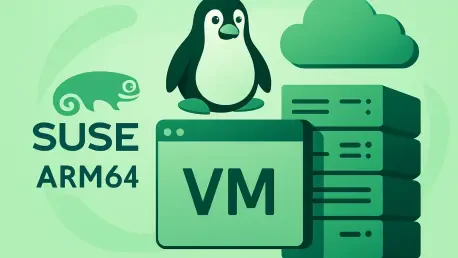In the heart of today’s data centers, a quiet revolution is unfolding as IT leaders grapple with skyrocketing demands for efficiency and scalability, while global data consumption is projected to reach 181 zettabytes by the end of this year, according to Statista. Organizations face an urgent challenge: modernizing infrastructure without breaking the bank or disrupting critical operations. Enter SUSE Virtualization on Arm64—a groundbreaking solution that promises to bridge the gap between legacy systems and cloud-native innovation. This technology, powered by the open-source Harvester project, is not just a tool but a potential game-changer for enterprises aiming to stay competitive in a data-driven world.
The significance of this shift cannot be overstated. As companies juggle traditional virtual machine (VM) workloads alongside modern containerized applications, the need for a unified, cost-effective platform has never been more pressing. SUSE Virtualization on Arm64, supported by energy-efficient processors from Ampere Computing, offers a pathway to streamline operations while slashing power consumption. This article delves into why this matters, unpacking key features, industry insights, and practical steps for adoption, all while spotlighting how this innovation is reshaping IT modernization.
Why SUSE Virtualization on Arm64 Deserves Attention
At a time when IT budgets are under intense scrutiny, finding solutions that deliver both performance and savings is paramount. SUSE Virtualization on Arm64 stands out as a strategic pivot, leveraging the open-source Harvester framework to integrate VMs and containers seamlessly. This approach addresses a core tension in modern data centers: maintaining legacy systems while embracing cloud-native agility, all without requiring a complete infrastructure overhaul.
Beyond mere functionality, this platform taps into the power of Arm64 architecture to redefine efficiency. Unlike traditional setups that often consume excessive energy, Arm64’s design—bolstered by Ampere Computing’s processors—promises higher core density and predictable performance with significantly lower power usage. For organizations looking to cut operational costs, this could translate into substantial savings, making it a compelling option for forward-thinking IT teams.
The Critical Push for IT Modernization in Data Centers
Across industries, data centers are buckling under the pressure to scale rapidly while maintaining reliability. Many enterprises remain anchored to outdated VM workloads, struggling to adopt container technologies that drive today’s digital economy. This disconnect creates bottlenecks, hampering agility and inflating costs at a time when every efficiency gain counts.
Sustainability adds another layer of urgency to this equation. With data centers accounting for roughly 1-1.5% of global electricity use, as reported by the International Energy Agency, the environmental impact of IT operations is under the spotlight. SUSE Virtualization on Arm64 emerges as a timely answer, offering a greener alternative through reduced energy consumption, alongside the flexibility to support hybrid workloads effectively.
The stakes are high, and the industry is taking notice. As organizations seek to balance innovation with continuity, solutions that unify disparate systems while addressing ecological concerns are gaining traction. This platform positions itself as a bridge to modernization, tackling both operational and environmental challenges head-on.
Unpacking the Power of SUSE Virtualization on Arm64
At its core, SUSE Virtualization on Arm64, built on Harvester, delivers a hyperconverged infrastructure (HCI) platform that simplifies the management of diverse workloads. Key components like KubeVirt enable seamless VM handling, Longhorn provides robust distributed storage, and Prometheus paired with Grafana offers deep observability. Together, these tools create a cohesive environment where traditional and modern applications can coexist without friction.
The standout advantage lies in Arm64 architecture, particularly through Ampere Computing’s processors, which are engineered for cloud workloads. These processors boast single-threaded cores for consistent vCPU performance, allowing data centers to achieve up to 30% lower power usage compared to traditional x86 systems, based on internal studies by Ampere. For a mid-sized enterprise running hundreds of servers, this could mean annual savings in the tens of thousands of dollars, alongside a reduced carbon footprint.
Real-world impact underscores these benefits. Consider a cloud service provider that recently adopted this technology: by consolidating workloads on Arm64 hardware, the provider reported a 25% increase in rack density, optimizing space and cutting cooling costs. Such examples highlight how this platform transforms theoretical advantages into tangible gains, redefining what’s possible in IT efficiency.
Industry Perspectives on Arm64 Adoption
Feedback from the field paints a vivid picture of SUSE Virtualization on Arm64’s potential. Alexandra Settle, Product Manager for SUSE Virtualization, has emphasized the platform’s role in enabling a gradual transition to cloud-native environments, noting its ability to “unify management across VMs and containers with minimal disruption.” Her insights reflect a deep understanding of the balancing act organizations face during modernization.
Similarly, Dave Neary of Ampere Computing has highlighted the architectural edge of Arm64, pointing out that “energy efficiency and high core density are no longer optional but essential for scalable data centers.” Community input from platforms like Rancher Users Slack further validates this, with users praising the platform’s stability during phased rollouts. One user noted a 20% performance boost in containerized workloads after migrating to Arm64, underscoring its practical value.
Rigorous testing and collaboration with partners have also played a pivotal role. Early adopters report that the platform’s general availability, following extensive quality assurance, ensures reliability across varied use cases. These voices collectively affirm that SUSE Virtualization on Arm64 is not just a concept but a proven solution poised to influence IT strategies broadly.
Actionable Steps for Modernizing with SUSE Virtualization
For organizations ready to embrace this technology, a structured approach is essential. Start by conducting a thorough assessment of current VM and container workloads to identify compatibility and prioritization for migration. Engaging with SUSE’s ecosystem of migration specialists can provide tailored guidance, ensuring that the transition aligns with specific operational goals and minimizes downtime.
Next, focus on leveraging Arm64’s sustainability benefits by planning hardware upgrades strategically. Pilot deployments on a small scale allow for testing and optimization before full rollout, reducing risks. Additionally, staying informed about upcoming integrations, such as expanded support for Rancher Manager in the coming years, can prepare teams for multi-cluster management capabilities that enhance scalability.
Finally, prioritize staff training to maximize adoption success. Equipping IT personnel with knowledge of Harvester’s Kubernetes-based framework ensures smooth operation and troubleshooting. By following these steps, enterprises can position themselves to build hybrid, resilient data centers that are ready for tomorrow’s challenges while reaping immediate efficiency gains.
Reflecting on a Modernization Milestone
Looking back, the emergence of SUSE Virtualization on Arm64 marked a turning point for countless organizations striving to reconcile legacy systems with modern demands. Its ability to integrate VMs and containers under a single, energy-efficient platform provided a lifeline for data centers under pressure to perform sustainably. The collaboration between SUSE and Ampere Computing stood as a testament to how innovation could address both economic and environmental imperatives.
The journey didn’t stop there, as the industry continued to evolve with each deployment. For those navigating IT modernization today, the next step involves exploring how this technology can be tailored to specific needs—whether through pilot projects or deeper partnerships with experts. Embracing such solutions offers a chance to not only keep pace but to lead in building data centers that are as sustainable as they are powerful.









